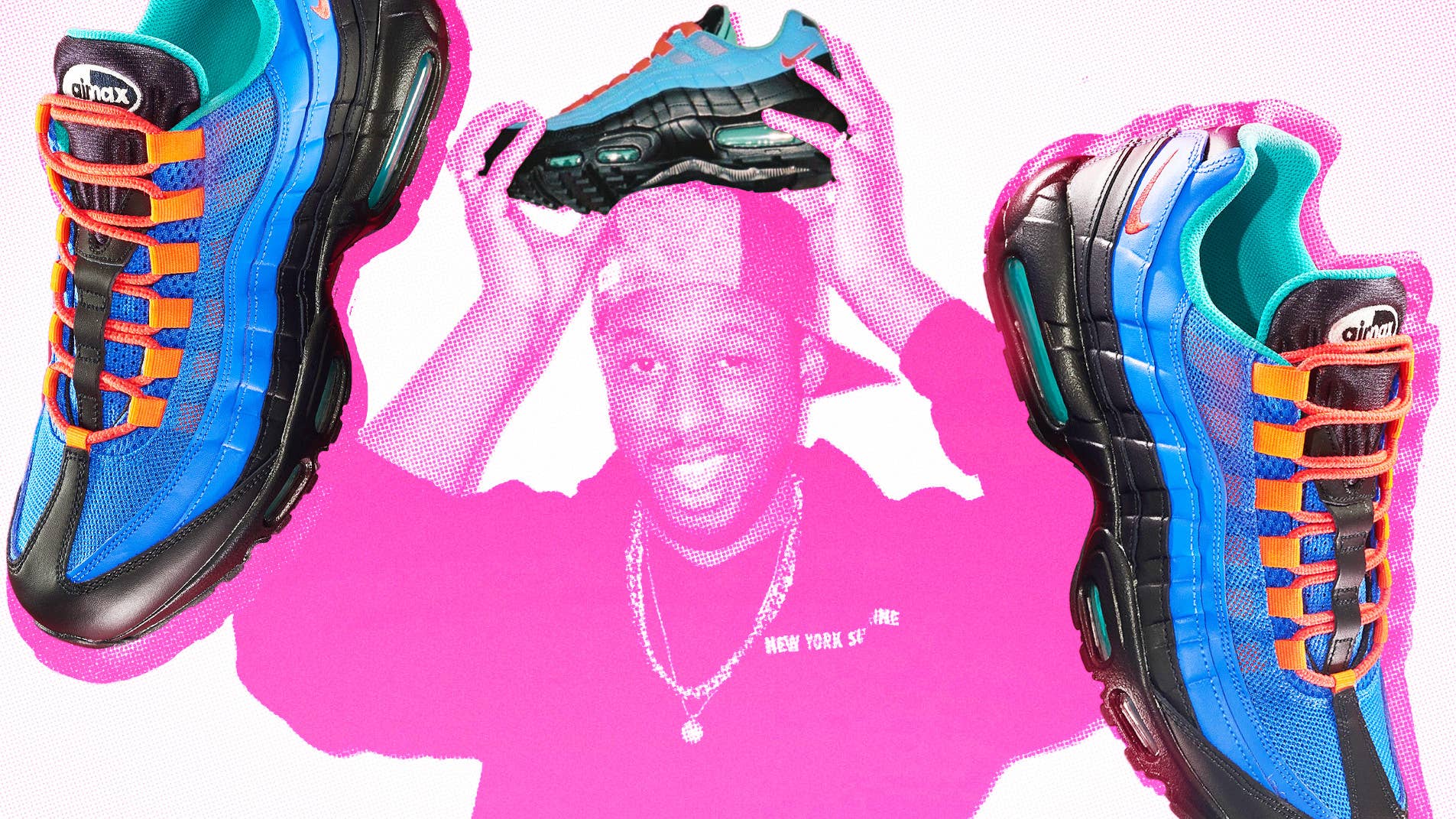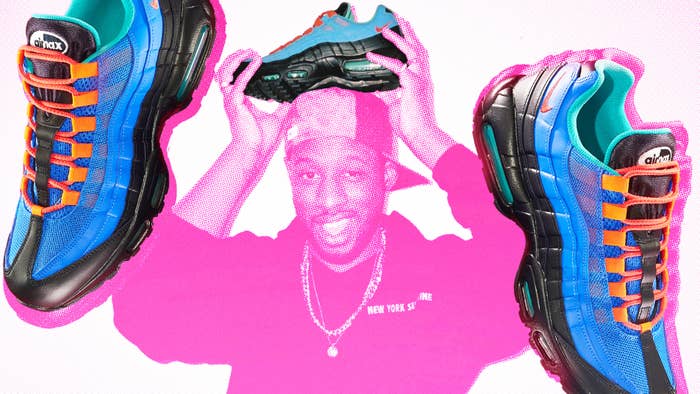
Nike. ASAP Mob. The Great Barrier Reef Foundation. These are just a few of the partnerships Coral Studios has established since the part-marketing agency, part-streetwear brand was started in 2013. Co-founded by Ismaila “Ish” Traoré and Henrik Hiort, Coral Studios has had a hand in a number of projects that readers have probably seen—and many they haven’t.
With a portfolio the founders say is shrouded in NDAs, some of Coral Studios’ more well-known endeavors include its oceanic Nike Air Max 95 from 2018 and a recent tribute to the late ASAP Yams for the annual Yams Day celebration. From the beginning, charity has also been an integral part of Coral Studios’ mission statement. The company is a partner of the Great Barrier Reef Foundation, an initiative which aims to protect and preserve coral reefs. The coral reef connection informs many of the brand’s designs and, according to Traoré, serves as a metaphor for Coral Studios’ out-of-sight approach.
The aforementioned Air Max 95 is set to return soon, albeit with a few modifications. Dubbed the Coral Studios V2, the revamped Air Max 95 will release Saturday, April 3 and features a similar colorway with new materials. Ahead of the drop, we caught up with Traoré and Hiort to find out about their history, working during the pandemic, and more.
Can you break down Coral Studios in your own words?
Ismaila “Ish” Traoré: For me, Coral Studios is just me and Henrik’s brainchild to express design in a way that allows us to create any point of view we want, but in a product-facing world. So anything that allows us to just create our opinion on anything, that’s what Coral Studios is the umbrella for. It’s our platform to be able to just make cool things and give our proposition to the world.
Henrik Hiort: Yeah, I mean, that pretty much hits it, but basically the coral reef is just kind of like our metaphor for the culture, and culture in general. We’re just kind of making a bigger impact through this, like how coral reefs have such a huge impact on the world, but nobody really knows about it. We’re living beneath the surface, working on projects that people may have not even known that we worked on, and just making an impact through that way rather than feeling like we have to be in the limelight about something.
Beyond the metaphor, from a more literal perspective, do either of you have a personal connection to the Barrier Reef? What spurred that groundworking for the brand?
IT: What was really interesting was that we both took a liking to being behind the scenes with our work. And I wouldn’t call either of us aquatic, but we do love nature and really cool things and phenomenons. One of the coolest phenomenons that we looked into, just naturally just being nerds, was the Great Barrier Reef or just the coral reef. Well, coral reef in general, but the Great Barrier Reef hosts, like, 30,000 living organisms, at the time we read up. It’s such a small piece of what goes on in the world, such a small piece of matter to have such a high concentration of living organisms within it. And that’s how we felt that our brains were. That’s how we felt we wanted our company to kind of emulate. High on frequency, but low in terms of positioning in the world. I think we did a pretty good job at that.
The team, is it just the two of you?
IT: No, me and [Henrik] are the co-founders, but we have a full team now. It’s over 10 of us now. We’re a little, small collective.
How would you describe your roles beyond that?
IT: Henrik is like… Man, it’s funny because I’m going to speak for him in this, but we’re legit married, our brains are married. Design-wise, he’s a wizard. A wizard amongst men when it comes to design, but he has a way of helping me pull out ideas that I have in my head that may be hard to understand, and he can see it. And that’s rare. Even if you know someone your whole life, it’s hard to find someone who can visualize exactly what you’re thinking. So I guess he’s a mind-reader as well. So for me, to pay it back to him, I’m like the hunter. So I’ll go get us the opportunities. I’ll give people the layman’s terms of our creations. And I guess I’m like the heartbeat. I like to push us forward.
HH: I think what’s nice about how we work is, we don’t necessarily… Nobody has an actual kind of goal. Of course there’s some people that just work on sort of operations and whatnot. But as far as the creatives, we’re all kind of working together, and maybe one day, helping sort of with direction, rather than design. Other days, I’m really heavily working on the design aspect. In that way, we’re kind of going back to the metaphor where we’re kind of flowing to the stream in that sense, going into whatever kind of avenue it puts us.
Looking back to the first Nike project, can you tell me a little bit how that original Air Max 95 happened? I know there was the connection with Lapstone & Hammer, and it was also associated with Nike’s Cultivator program.
IT: It’s a wonky story. It’s a fun one though. My OG, Ferris Bueller, was working with Nike Portland on a really small, little niche program that they had. Through that I was being nosy and just kind of found out about the program and reached out to the leads of it, and they kept us in mind. I also referred people who were clients of Coral Studios at the time and oddly enough, they chose us to work on the program. It wasn’t necessarily called Cultivator at the time. It was still being built out. From there, we just already had a point of view of what we wanted to do. It was perfect timing for us because we really landed on our feet with what we were doing. So the original program, it wasn’t Cultivator at first. It was Sneakerlab, then turned to Cultivator, and now it’s done through Nike By You. So the program was more about just understanding how influencers work with shoes on a micro level to be able to get statistics for it. What’s crazy is that we understand marketing much better than a normal person of interest, clearly. Because of that, it allowed us to really lay out a groundwork that allowed us to really blow up our opportunity.
Through that, Brian Nadav from Lapstone & Hammer was really interested in our point of view, as well. Our shoe was charity-based, and he’s a very giving guy, Lapstone gives a lot. We came together and thought that our release should be able to speak towards his audience as well. And because of that, the sneaker community picked up on that, and it became just this crazy Cinderella moment for us. Even down to Nike reps having an actual carrier come to Philadelphia and ship the shoe by a car, all the way to Nike NYC for Virgil Abloh. That was when we knew that like, whoa, this project is a lot bigger than just the program that they told us about.
What was interesting for the program was that you purchased the shoe, and then the proceeds went to charity. And hundreds of people bought the shoe. So it’s weird, because people say there’s only 50 pairs, but that was just for Lapstone. There’s plenty of them out there. That’s why there’s a grey sole and a black sole when you see them on reselling sites and things like that. There were two different editions. The thing was though, was that the shoe wasn’t hyped yet. So the shoe kind of went under the radar when the initial release happened.
Are there any other sneakers you worked on that you can talk about?
IT: That are Nike related, no, but in terms of shoes, we did do a George Cox boot. That was pretty crazy, because the silhouette we used last time is the silhouette NIGO uses for his Human Made brand. So to get permission to use that boot, and to collaborate with that company, was an epic moment for us.
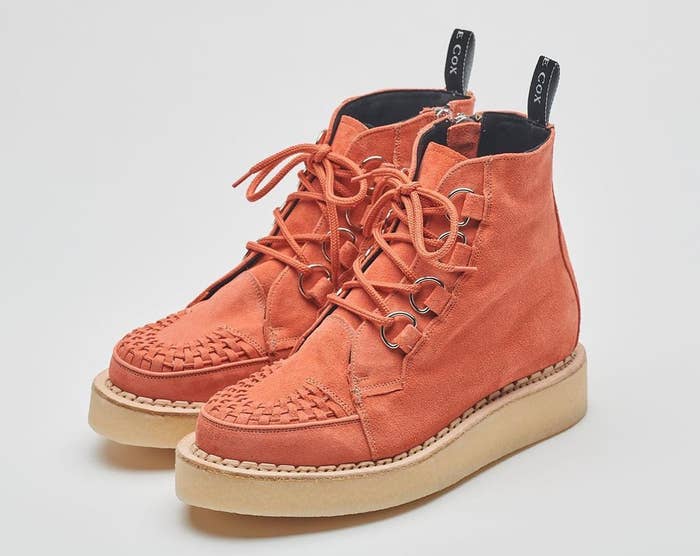
How about some of the other projects you all have done? I know there’s the Umbro jerseys, the sunglasses. Most recently, you had the Yams Day thing, which seemed like it was a huge look.
IT: Man, I definitely want to let Henrik rock on that, but one thing I will say is what we did was, we took our time to make our own camouflage. So we own our own camo, and Henrik, it took him probably a month to perfect it. We literally made our own camouflage out of coral reef. Through that, it kind of sparked us taking this collaborative journey with other companies that started seeing our story and just felt that, “Hey, we like where you guys align with your community. And we want to speak to that community as well.” So with Umbro, being able to make jerseys out of fishing nets out of the ocean, and it was upcycled, was unreal for us. I know me and Henrik couldn’t believe that we had the opportunity to give people that on that level.
HH: Yeah. Then, as far as the end-stage stuff, that was something that we had to kind of come up with real quick, but it was just kind of one of these things that we saw. We were able to sort of repurpose some of our design language to create this camo, which could represent ASAP Yams in a way. We incorporated his birthmark into that camouflage, and then changed the colors of it, to be able to create this bucket hat that kind of embodies this whole idea we had around Yams Day. That was definitely a good look for us and like a fun little project that we could have put out there for everybody.
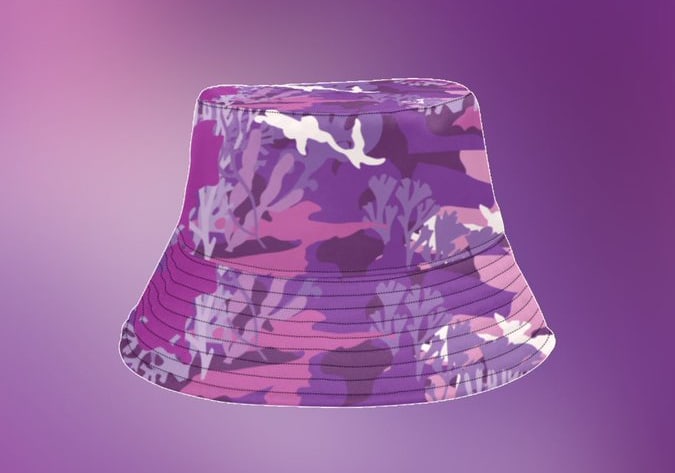
The Yams Day one got a big reaction on the internet.
IT: Absolutely. Which was full circle for us, especially me being from Harlem. Just seeing ASAP from afar, and seeing how they came up. Just being able to pay that energy forward and give that energy to his fans and being able to meld with our fans and seeing it from a design standpoint, not just a novelty standpoint, was really cool.
HH: And of course, how the money went to charity. That again kind of just loops into what we’re doing.
Is that something that you would say you aim to do with every project, to have a philanthropic angle to it?
IT: Yeah. We like to pay it forward because we understand that in that realm, that’s where we live best. Because we design for a purpose, but the purpose isn’t always to just have people react, but it’s also to trick people into loving hyped items, but still being able to give back, through that love. You really don’t get to see too many charitable hype things. Usually, if something’s charity based, people may feel maybe the design lacks that feeling of cool, or that feeling of evolution. The fact that we like to marry that every chance we get, it’s just a call back to how clever the company is in general.
What’s it been like working during the pandemic? Have you faced any challenges related to that?
HH: One thing that kind of prepared us for this pandemic, is me and Ish have been working remotely since we started. So in reality, nothing’s changed for us as far as working, but we just released something with Nordstrom. That was kind of a culmination of us being at home during this pandemic and just full-on working on this project for who knows how long, and just being able to properly create these products that are coming up.
IT: The pandemic has been interesting, because for us being away from each other, as long as we have that cloud in the air, then we can design. But in terms of how we like to activate, which is usually doing [something like] Art Basel with some of our favorite collaborators, like New York Sunshine, it’s been rough because we do also have many languages that we’d like to give to people. One of them is physical spaces and pop-ups. Because of that, we made sure that we’ve laid down more proper messaging when we’re creating things moving forward.
And you have been working remotely together for how long?
IT: For me and Henrik, I say what, seven, eight years? We’ve been doing this for a very long time. Me and the co-founder, me and him have never lived in the same city. Ever.

Another thing that struck me about Coral Studios was that you have a ton of connections in the industry already, despite being somewhat young and up-and-coming. How would you say you established a lot of that? How do you approach networking?
IT: A lot of work me and Henrik did early on was behind-the-scenes work. So it was some NDA work, or if it was some behind-the-scenes work for some people’s latest and greatest. We’d work on it, and some of it is stuff we still can’t speak on, but it was with the industry’s best. So through that, when there’s opportunities to finally use your voice, which we did, in podcast form, or just being educational always, or just putting the people and the product first or the storylines first. It allowed us to start having respect given to us because people knew we were in it for the right reasons.
For me, just really being a culturalist and really being in it, having true relationships with people like Skepta, I mean growing up around people like the ASAP Mob. People like Tremaine Emory and Acyde being my mentors, and also just being open to meeting new people and sharing information with these people, allowed for us to grow within the industry in a very proper way. Instead of just chasing fads and trends, we were really out here, outside at parties, at real design workshops, really just trying to learn. We also are a part of, I call it a graduation class of creators that are up next, like the Bstroys, and the Reginald Sylvesters, and the New York Sunshines, and Aleali Mays. I’ve known Aleali since she worked at RSVP Gallery. So it’s just by coincidence we both kept at it with our own dreams, and now we parallel a lot.
Shifting to the present day and what’s next, I want to talk about the new Coral Studios x Air Max 95 V2s. What can you tell me about those?
IT: Oh man. So I’ve been calling it our love letter to the people, because one thing we realized once everyone couldn’t get the first one, was that people really liked the shoe, man. For some people, it’s their top five Air Maxes, of all time. And definitely top three Air Max 95 of all time, along with the original Neon or the Stashes. We have to pay homage to Stash, because his use of blues, to this day, is still standing the test of time. But for us, we wanted the shoe to evolve with us, and we wanted to allow people to covet the shoe even more. Me and Henrik, we aren’t crazy. We understand the sneaker community. We understand they’re selling the shoe right now for thousands of dollars on resale sites. We wanted people to be able to enjoy the ride a little longer.
The original shoe has all suede panels and a suede upper. This time, we wanted to give people more of a luxe feel, but also allow them to enjoy the shoe longer, and not trash the shoe. Then again, Henrik being so genius, suggested that we should have a recyclable box, or a box that you can fold down and store easily. So it’s speaking a sneakerhead language, but also, speaking our upcycle language and just being able to preserve the environment better. The box can just really go both ways. Whether you want to keep it and take the adhesive off and make it just a stand-alone box or break it down, we’ve given people that option.
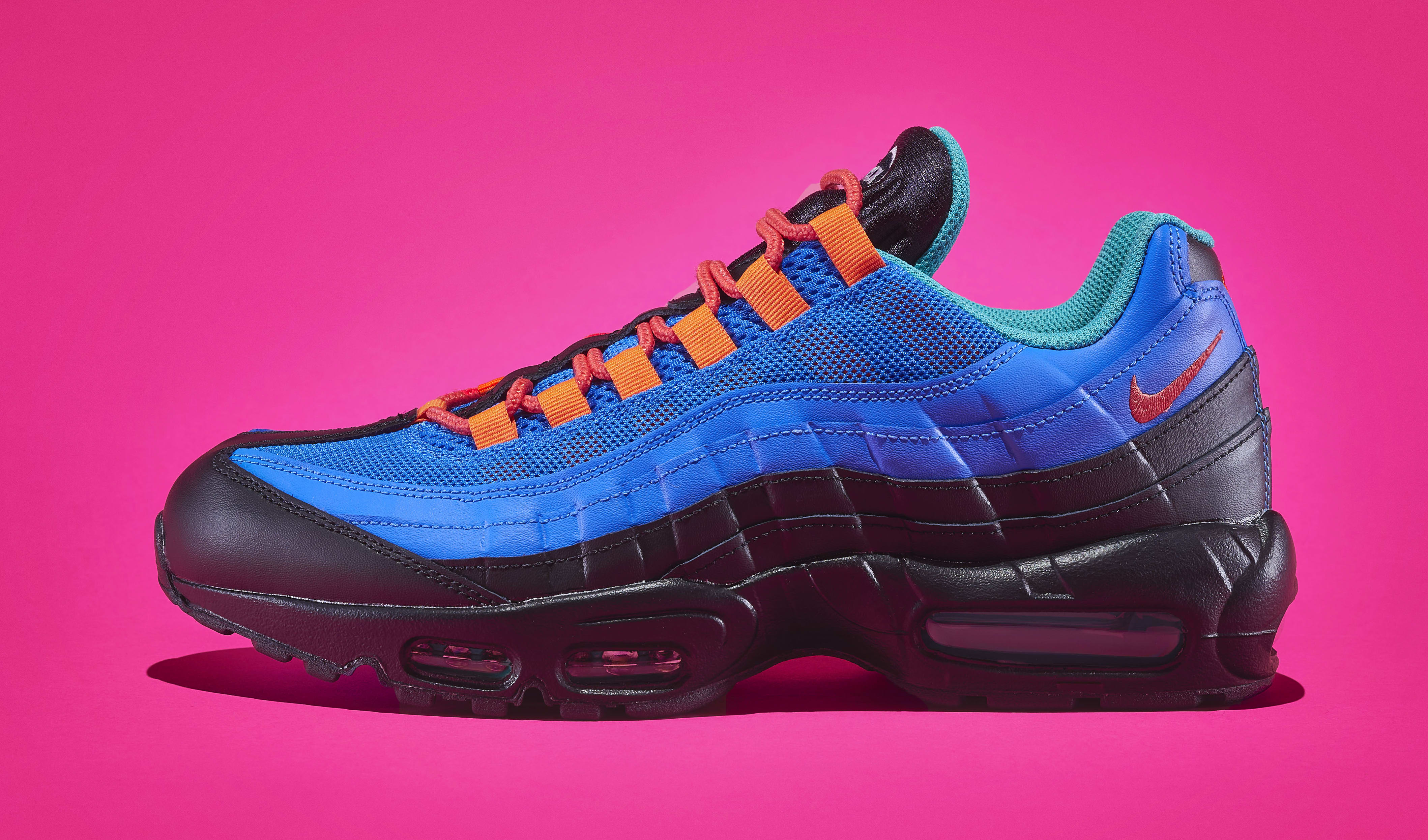
The new V2 Air Max 95s, are they going to be more available than the first round?
IT: I’d say yes and no. Because I feel like the people who initially bought them, had bought them, and it was more or less, it was like, “Hey, I just want to support.” So this time, it’s going to be a lot more accessible because I guess they know now. But also, it’s going to be worse because we have a much bigger audience. So even if there’s more, there’s more eyes on us, it’s a double-edged sword of that response, I guess. Yes and no, for sure.
HH: Exactly. There are more pairs, but the demand is higher. It’s just kind of the way it is. We don’t know how it will go. I’m sure it will go quick, but we hope everybody who wants it can grab it.

